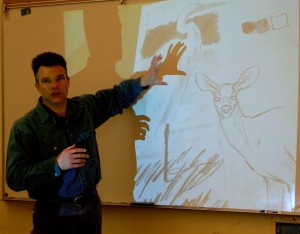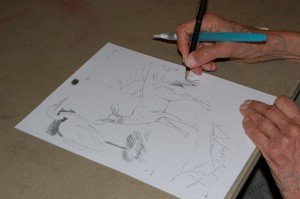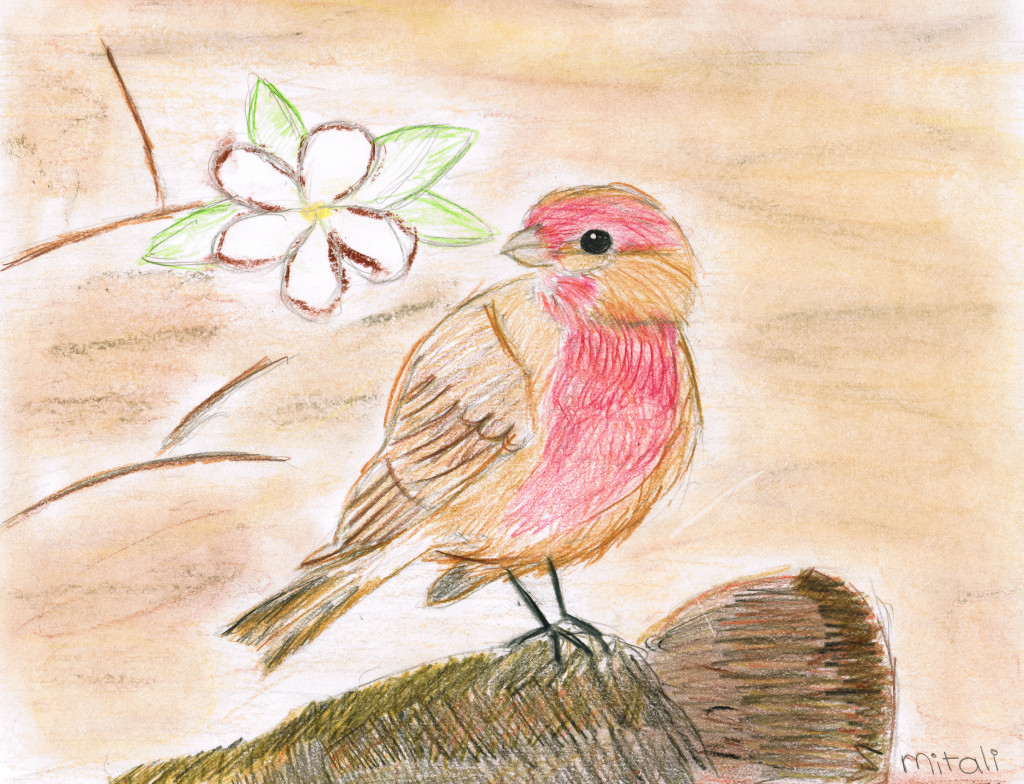John Muir Laws, affectionately known as “Jack,” hugs and greets each person who enters his classroom as though they’ve known each other for a lifetime.
Sitting side-by-side in a small classroom at the San Francisco Zoo, his students, young and old, unpack their “nature journaling kits,” spreading pencils, pens and paintbrushes across their classroom tables.
“I want you all to go away from today knowing at least two new people,” says Laws as he kicks off his nature journaling workshop, which he hosts monthly in multiple locations across the Bay Area.

Laws believes the craft of nature journaling– observing the intimate details of the natural world by creating images — will spark a connection with nature, and each other, that evolves into stewardship.
“One of the most useful and interesting definitions of love is that it is sustained, compassionate attention– and that’s what you’re doing when you are drawing a wildflower,” says Laws. “That love, that’s where stewardship is mostly born. We don’t protect that which we don’t know, understand and connect with.”
Laws speaks from experience. He credits his own appreciation of the natural world to journaling. As a child, his family took him on long hikes through the Sierra Nevadas, and he spent his time catching lizards and frogs and turning over every rock in sight. To chronicle his adventures, Laws said he would bring a journal and a pen, and sketch his discoveries, rather than capture them with words (he is severely dyslexic).
The sketching focused him on nature’s details — the thickness of a gull’s neck, the markings of a sparrow, the symmetry and shape of a wild flower’s petals.
“If you start drawing and sketching what you see, it forces you to look at a much deeper and profound level,” Laws said. “It focuses your attention to such a degree that you develop a relationship between you and whatever it is that you are observing, and that is a really powerful connection.”
Catalyzing Community
But pen and paper alone rarely turn a naturalist into a steward. Laws sees community with other people as the other essential component necessary to sustain a love for nature. In the absence of others, even the most enthusiastic nature-lover can quickly lose touch with the natural world.
Leena Khanzode, one of Laws’s nature journaling students, is a prime example. And so is Joseph Kinyon, Laws’s previous colleague and fellow nature journaler.

Prior to his current nature journaling club, Laws taught nature journaling classes from time to time. Khanzode and Kinyon were enthusiastic attendees, but nothing would stick. Both fell victim to a phenomenon Laws has seen time and again.
People would show up to the classes, saying they’d always wanted to keep a nature journal and were taking the class to jumpstart the process, and leave inspired. Laws would also leave inspired, feeling like he was really connecting people to nature. But 15 months later, the same person would show up and say they hadn’t been drawing and that they wanted to jumpstart themselves into nature journaling again. This happened to Khanzode and Kinyon, as well as other diehard nature journalers.
“I realized that even though people were enjoying the class, it wasn’t translating into a change in behavior. People were taking the class because they wanted to nature journal on a regular basis, but if it wasn’t their habit to do it before taking the class, then it would not be their habit to do it after class,” says Laws.

Devastated that his classes were ultimately failures in his mind, Laws began to think back to an under-the-radar program he was a part of years ago. Similar to a regular Sunday pickup game of soccer, Laws would meet regularly with friends and acquaintances to draw nature. It was this repeated reunion with nature journalers that encouraged him to regularly keep a nature journal and even draw in between.
“One of the most important things in establishing a new habit– whether it’s losing weight, quitting smoking, or picking up nature journaling– is to do it as part of a community. That community helps people be able to maintain and develop a new habit,” says Laws.
A club is born
The idea of his current nature journaling club was born. Providing monthly workshops and field trips, Laws’s nature journaling club gives participants the kind of structure they need to keep going.
No longer attending in gaps of up to a year, Khanzode and her family have shown up to every workshop and field trip thus far.
“Jack’s passion is infectious,” says Khanzode. “Everyone is passionately sketching and talking about nature, talking about what plants and birds they saw. It’s just so amazing, it’s hard to express it in words. You come back rejuvenated.”

Khanzode and her family have been nature-lovers for quite some time (her husband is also on the board of the Santa Clara Audubon Society), but nature journaling adds something to the mix.
“This is a whole new spin,” she said. “When you actually go out and sketch a bird, for example, you look at its behavior, the environment around it, how it perches, what it feeds on. You look at things differently and learn so many things. Even simple birds, like song sparrows, look so differently to me now.”
Khanzode’s daughters, 11 and 7, have also picked up the nature journaling bug: “Excited is an understatement.”
Kinyon has made it a point to save one Sunday a month for a day out in the field with his 2-year-old son, joining the rest of the nature journaling community around the Bay Area.
“It’s meditative,” he says. “It helps us sharpen our mind and see something that we may not have noticed before. It’s a tool for looking, a place to write questions, and reflect.”
Those questions, Kinyon explains, are like jellyfish– slippery and short-lived, they float through our brains, and “if we don’t write them down, they’re gone.”
As each outing comes to a close, more than 100 field trip participants congregate in a circle and place their artwork in the center to discuss anything from drawing techniques to their experiences in the field. They’ve also created a Facebook page where they post their drawings and continue the discussion well beyond the field trip.
It’s this sense of community–the exchange of conversations and ideas–that Laws believes is key to protecting the wild places of the world.
“If we can get a critical mass of energy behind nature journaling, there will be some other emergent property that will come out of all of this energy, and that is what makes the hair stand up on the back of my neck,” he says.
More information on the Bay Area Nature Journal Club is on Laws’ website.
John Muir Laws has regular illustrations in Bay Nature Magazine. Courtney Quirin is a contributor to Bay Nature and an avid illustrator, herself.





